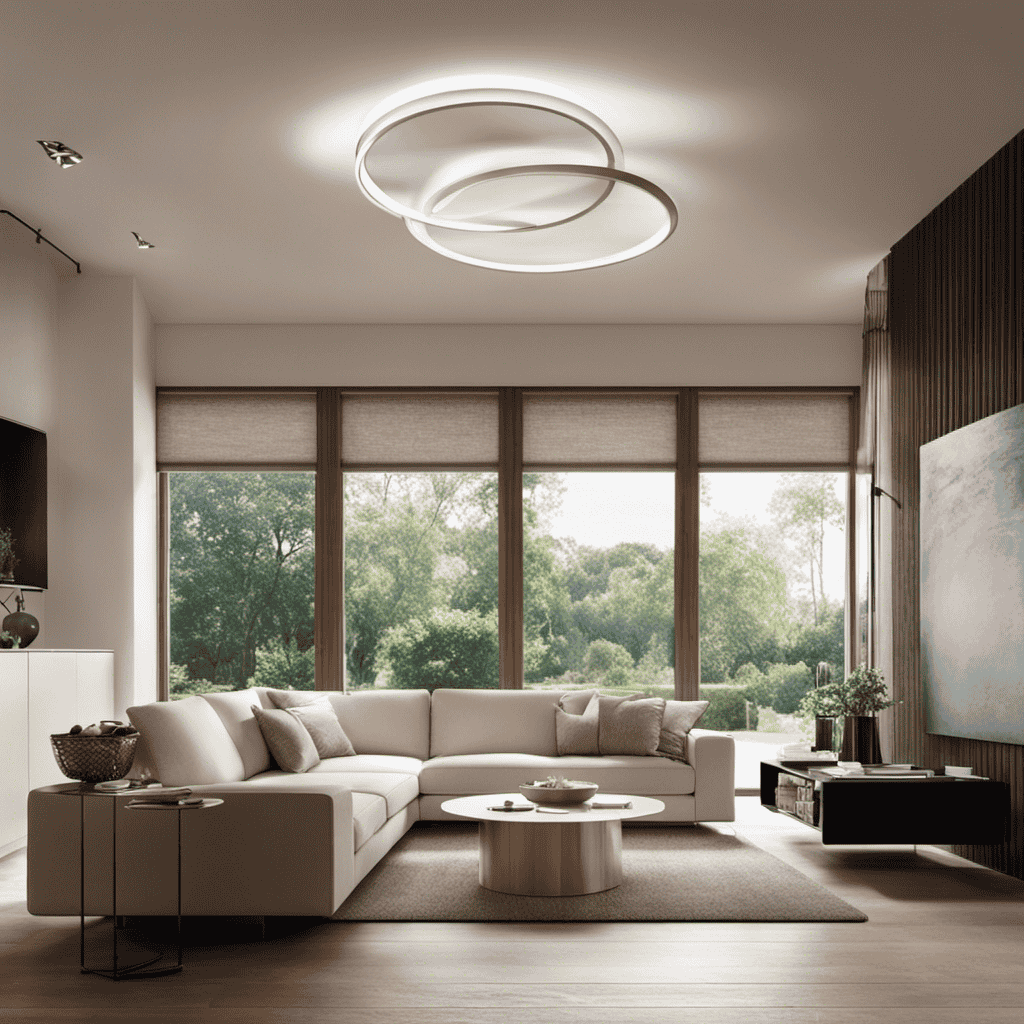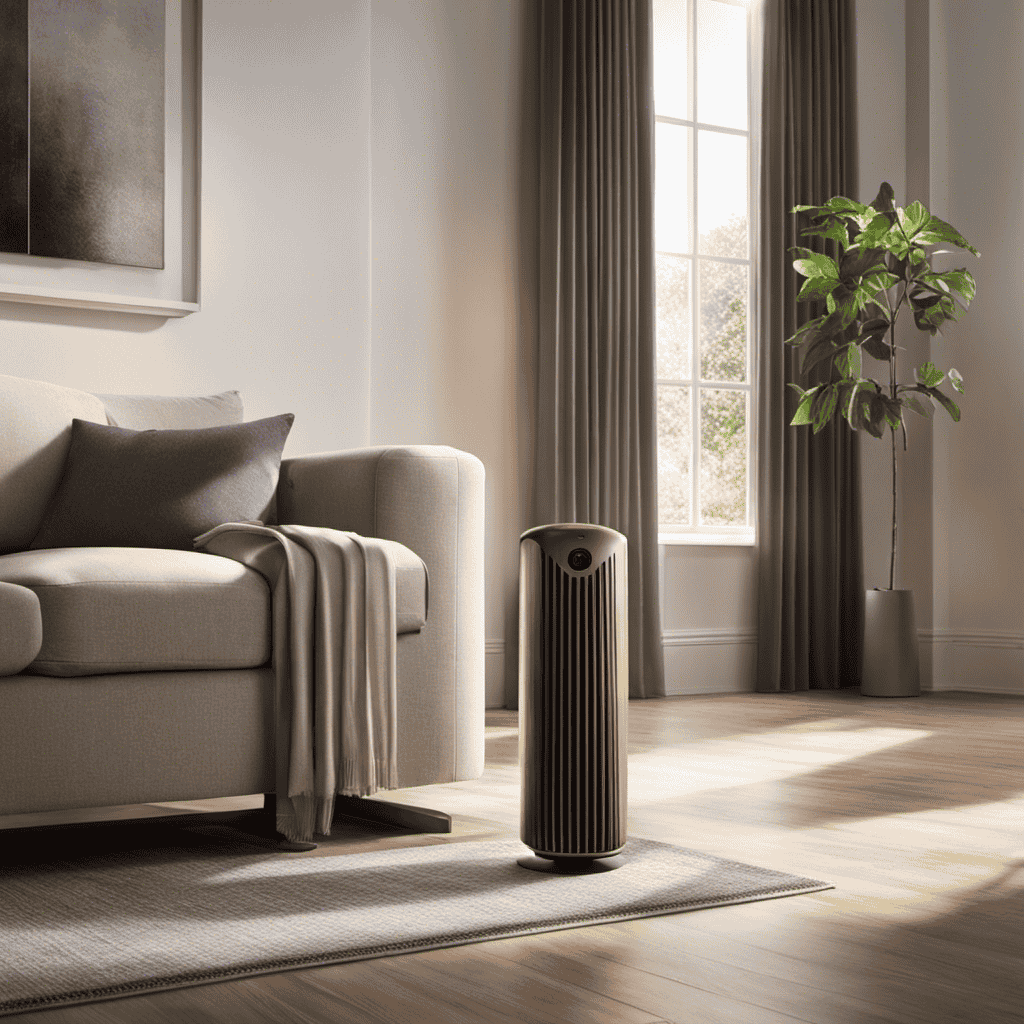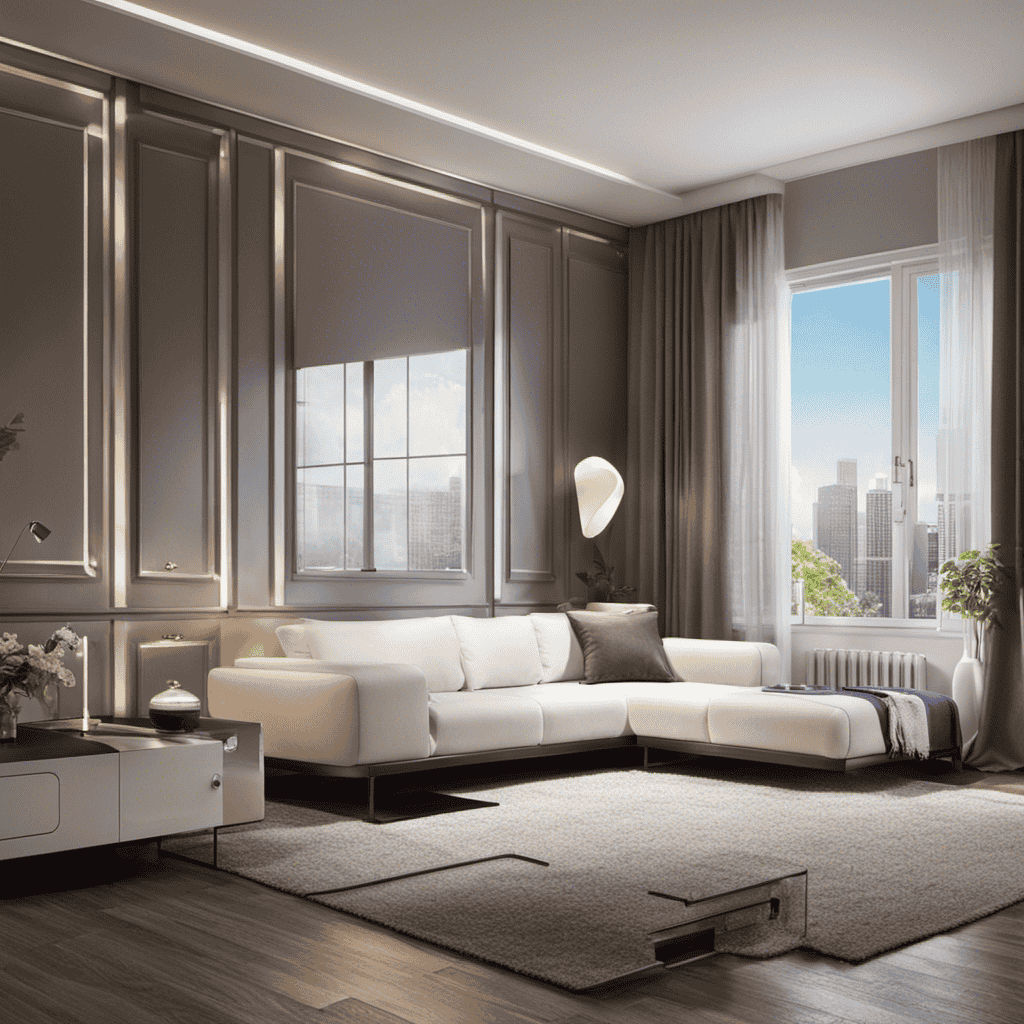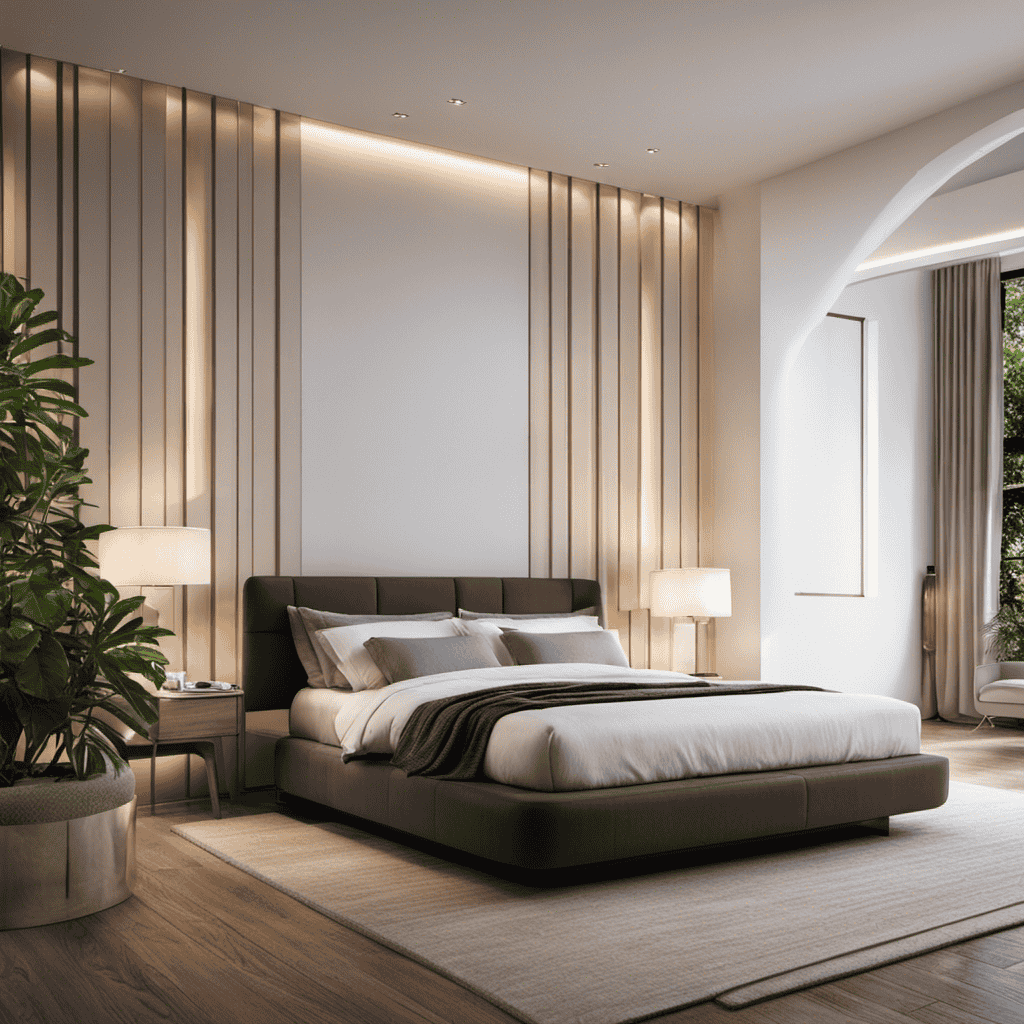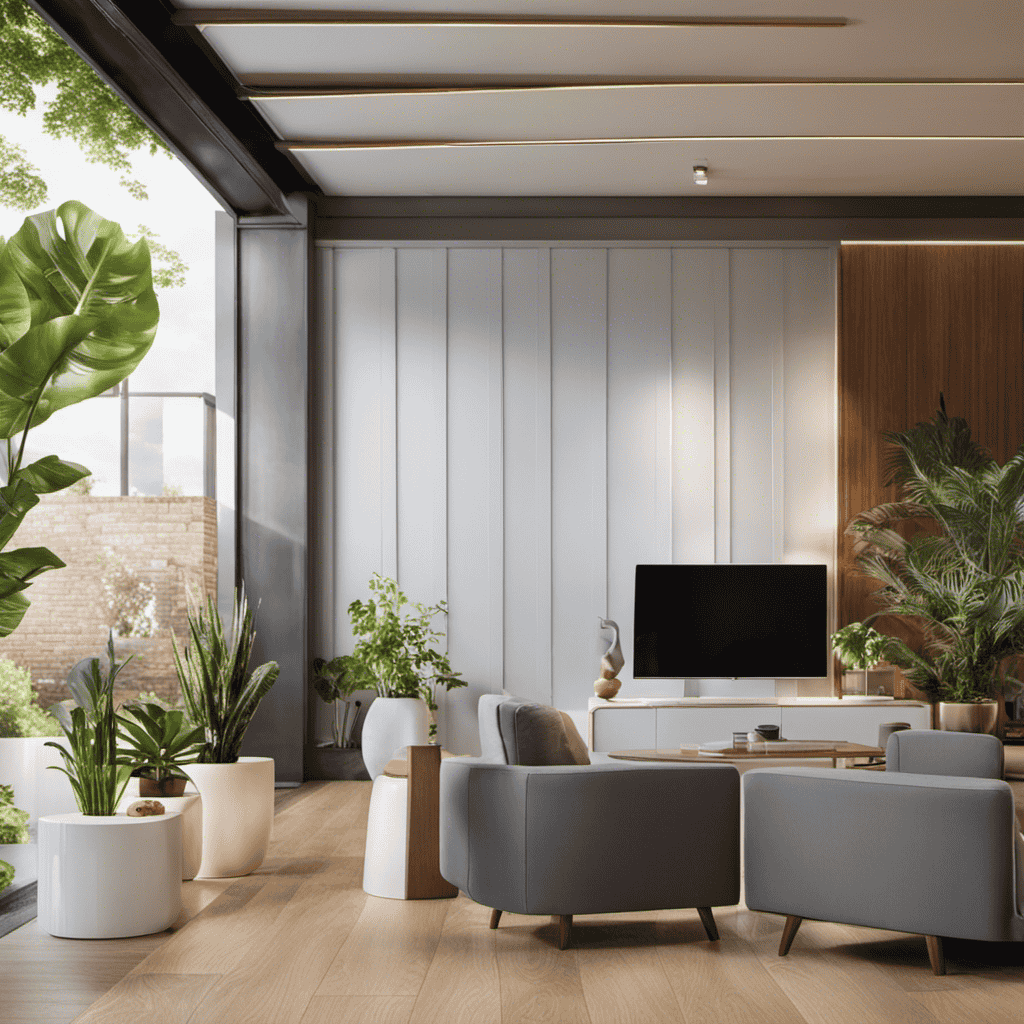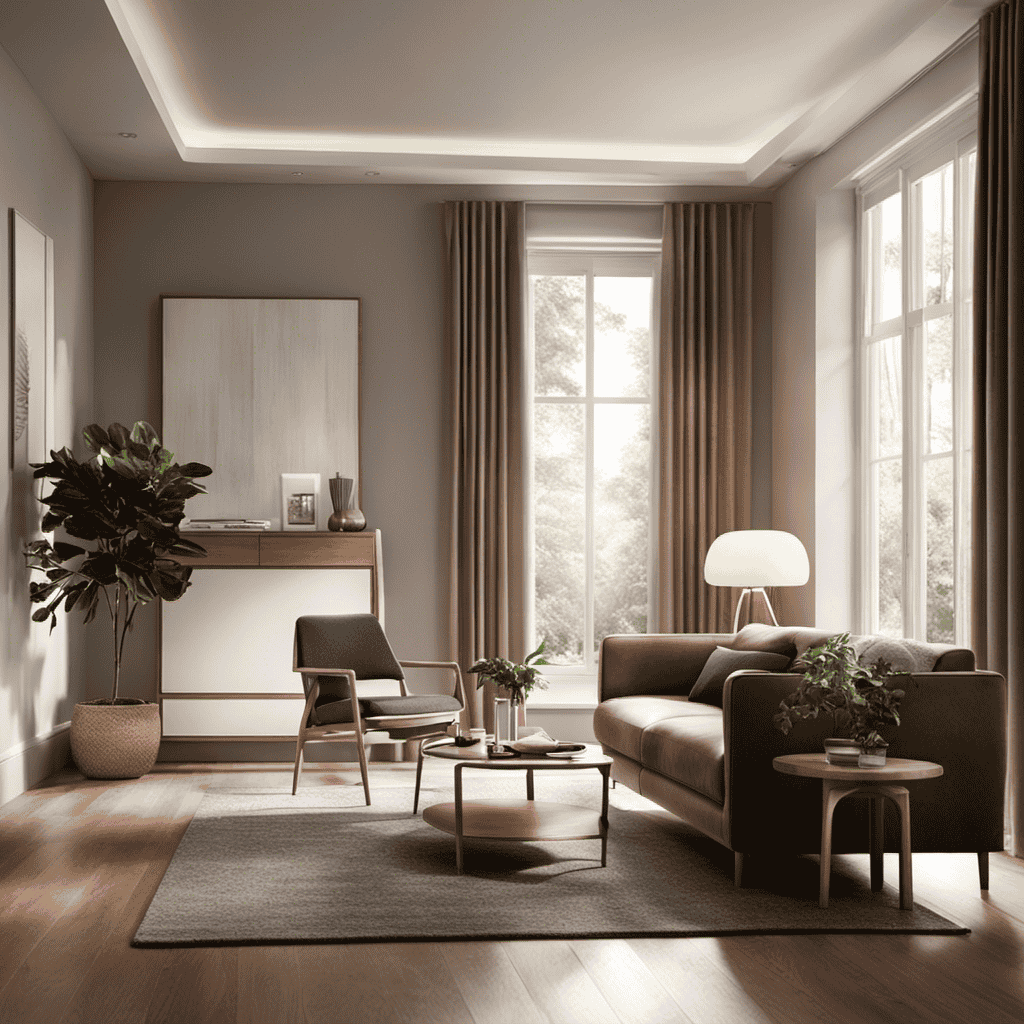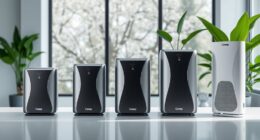I have always been curious about the optimal duration for running my air purifier to maintain the highest air quality in my home. After conducting extensive research, I have come across some interesting findings that I am excited to share with you.
In this article, we’ll explore the benefits of leaving your air purifier on, factors to consider when determining its runtime, and the impact of room size and seasonal allergies on its operation.
We’ll also discuss how to monitor and control its runtime and the importance of regular maintenance for optimal performance.
Get ready to learn everything you need to know about air purifier runtime!
Key Takeaways
- Factors such as room size, initial air quality, allergies, and type of contaminants affect the runtime needed for effective air purification.
- Energy-saving features like programmable timers and sleep modes can optimize runtime and reduce energy consumption.
- Adjusting air purifier runtime for seasonal allergies can target peak allergy seasons, save energy, minimize noise disruptions, and create a comfortable indoor environment.
- When considering pets and air purifiers, factors such as pet dander, HEPA filters, space size, seasonal shedding, and allergy management should be taken into account to determine the appropriate runtime.
The Benefits of Leaving Your Air Purifier on
Leaving your air purifier on has numerous benefits for improving indoor air quality. By maximizing the effectiveness of your air purifier, you can significantly impact the quality of the air you breathe. Studies have shown that continuous operation of an air purifier can help remove pollutants such as dust, pet dander, pollen, and mold spores from the air. This is especially beneficial for individuals with allergies or respiratory conditions.
Leaving your air purifier on ensures that it continuously filters and circulates the air in your space, preventing the buildup of pollutants. Additionally, running the air purifier on a consistent basis helps maintain a clean and healthy environment by reducing the presence of unpleasant odors.
To maximize the impact on indoor air quality, it is essential to follow the manufacturer’s instructions regarding the recommended duration for running the air purifier. Some purifiers are designed to be used continuously, while others may have specific time intervals or settings. Regularly cleaning or replacing the filters is also important to maintain the effectiveness of the purifier.
Factors to Consider When Determining Air Purifier Runtime
When determining the runtime of an air purifier, it’s important to consider various factors. Here are three key factors to consider when deciding how long to leave your air purifier on:
-
Nighttime usage: Many people prefer to run their air purifiers at night to ensure clean air while they sleep. This can help reduce allergies and improve overall sleep quality.
-
Impact on electricity bill: Running an air purifier for extended periods can lead to increased electricity consumption and higher bills. It’s important to find a balance between air quality and energy efficiency.
-
Air quality needs: The runtime of an air purifier will depend on the air quality in your home. If you live in an area with high pollution or have specific respiratory issues, you may need to run the purifier for longer periods to maintain clean air.
Considering these factors will help you determine the appropriate runtime for your air purifier, ensuring both clean air and energy efficiency.
How Long Should You Run Your Air Purifier
To determine the appropriate runtime for your air purifier, it’s important to consider factors such as nighttime usage, impact on your electricity bill, and your specific air quality needs. Adjusting air purifier settings can help optimize its performance and extend its runtime.
When it comes to recommended air purifier runtime, experts suggest running it continuously in areas where air pollution is a concern, such as during wildfire seasons or in highly polluted cities. However, if you only need air purification during specific times, like when you’re sleeping or when you’re not at home, you can adjust the runtime accordingly.
It’s also worth noting that running your air purifier 24/7 can lead to higher energy consumption and increased electricity costs. Therefore, finding a balance between air quality needs and energy efficiency is key when determining how long to run your air purifier.
Understanding Air Purifier Auto Mode and Timer Settings
When it comes to using an air purifier, understanding the optimal timer duration and the effectiveness of the auto mode is crucial.
The optimal timer duration refers to the amount of time you should run your air purifier to achieve the best results.
Additionally, the effectiveness of the auto mode determines how well the air purifier adjusts its settings based on the air quality in your space.
In this discussion, we will explore the research-based recommendations for timer duration and delve into the factors that contribute to the effectiveness of the auto mode.
Optimal Timer Duration
You should set the optimal timer duration for your air purifier based on the specific needs of your space. Maximizing efficiency and ensuring the best impact on air quality are crucial factors to consider. Here are three key points to keep in mind when determining the ideal timer duration for your air purifier:
-
Room size: Consider the square footage of the room where the air purifier is being used. Larger spaces may require longer durations to adequately clean the air, while smaller rooms may need less time.
-
Air quality: Assess the air quality in your environment. If you live in an area with high pollution levels or have respiratory issues, you may want to run the air purifier for longer periods to maintain cleaner air.
-
Occupancy: Take into account how often the room is occupied. If it’s a frequently used space, it may be beneficial to run the air purifier for longer durations to continuously filter out pollutants.
Auto Mode Effectiveness?
The effectiveness of auto mode on an air purifier can vary depending on the specific needs of your space. Auto mode is designed to automatically adjust the fan speed and filtration level based on the air quality in the room. This means that the air purifier will work harder when the air is more polluted and will reduce its power when the air quality improves. However, it’s important to note that auto mode may not always be the most efficient option. It’s recommended to refer to the manufacturer’s guidelines and consider factors such as room size, air quality, and personal preferences to determine the optimal settings for your air purifier. Additionally, regular air purifier maintenance is crucial to ensure its optimal performance and longevity. Here are some maintenance tips to keep in mind:
| Maintenance Tips | Impact on Electricity Bill |
|---|---|
| Clean the filters regularly | Minimal impact |
| Replace filters as recommended | Minimal impact |
| Keep the air purifier away from obstructions | Minimal impact |
| Use the air purifier only when needed | Moderate impact |
The Impact of Room Size on Air Purifier Runtime
The size of the room affects how long you should leave the air purifier on. The larger the room, the longer the air purifier should run in order to effectively clean the air.
Here are three reasons why room size is important in determining the optimal air purifier runtime:
-
Air circulation: Larger rooms have more air to circulate, so it takes longer for the air purifier to filter out pollutants and allergens.
-
Pollutant concentration: In smaller rooms, pollutants and allergens can quickly accumulate, requiring the air purifier to run for a shorter period of time to maintain clean air.
-
Room layout and furniture: Obstacles such as walls and furniture can impact air circulation and filtration, making it necessary to run the air purifier longer in larger rooms with more obstacles.
To determine the optimal runtime for your air purifier, consider the size of your room and the level of pollution.
How to Determine the Optimal Runtime for Your Air Purifier
Determining the optimal runtime for an air purifier involves considering factors such as room size and pollution levels. To adjust the runtime for different room sizes, it’s crucial to understand the air purifier’s Clean Air Delivery Rate (CADR) and the Air Changes per Hour (ACH) required for a specific room size.
The CADR is a measure of the purifier’s effectiveness in removing pollutants from the air, while the ACH refers to the number of times the air in a room is completely replaced with clean air. By matching the CADR and ACH values with the room size, you can determine the optimal runtime for your air purifier.
Additionally, it’s important to note that the impact of air purifier runtime on sleep quality should also be considered. While it may be tempting to leave the air purifier on all night, excessive noise or disturbed sleep may occur. It’s best to find a balance and adjust the runtime to ensure a comfortable and restful sleep environment.
Maximize Air Purifier Efficiency With Proper Runtime
When it comes to maximizing the efficiency of air purifiers, determining the optimal runtime duration is paramount. The duration of time that the air purifier is running directly affects both its energy consumption and its overall effectiveness in improving air quality.
Understanding the impact of runtime on energy consumption and the benefits of longer runtime can help users make informed decisions about how and when to use their air purifiers.
Optimal Runtime Duration
To get the most out of your air purifier, you should consider how long you can leave it on. Maximizing the effectiveness of your air purifier requires finding the right balance between runtime and energy consumption. Here are three important factors to consider:
-
Room Size: Larger rooms may require longer runtime to ensure thorough air purification. Smaller rooms, on the other hand, may require less runtime to achieve the desired air quality.
-
Indoor Air Quality: If you live in an area with high pollution levels or have respiratory issues, you may need to leave the air purifier on for longer periods to maintain clean air.
-
Occupancy and Usage: If the room is frequently occupied or is prone to allergens and pollutants, longer runtime is recommended to continuously filter the air.
Finding the optimal runtime duration for your air purifier will not only maximize its effectiveness but also ensure that you’re not wasting unnecessary energy.
Now let’s explore the impact of air purifier runtime on energy consumption.
Impact on Energy Consumption
Finding the right balance between runtime and energy consumption for your air purifier is crucial in optimizing its effectiveness.
When it comes to maximizing energy savings, it’s important to understand how long you should leave your air purifier on. Studies have shown that running the air purifier continuously may not necessarily lead to better air quality. In fact, it can increase energy consumption without significant benefits. The key is to find the right balance.
It is recommended to run the air purifier for a few hours each day, especially during times when pollutants are more likely to be present, such as during cooking or cleaning.
Additionally, using features like timers and sensors can help regulate the runtime and reduce energy consumption, without compromising on air purification efficiency.
Benefits of Longer Runtime
Running the air purifier for extended periods can create a healthier environment by effectively reducing pollutants. Here are three ways maximizing the runtime of your air purifier can have a positive impact on air quality:
-
Continuous Filtration: Leaving the air purifier on for longer periods allows it to continuously filter the air, trapping and removing harmful particles such as dust, pollen, and pet dander. This helps to improve indoor air quality significantly.
-
Odor Elimination: Extended runtime enables the air purifier to effectively eliminate unpleasant odors caused by cooking, pets, or smoking. By continuously circulating the air and capturing odor-causing molecules, it helps to create a fresher and more pleasant living space.
-
Allergen Reduction: Keeping the air purifier running for longer helps to reduce common allergens like mold spores and mites. This can be particularly beneficial for those who suffer from allergies or asthma, as it minimizes triggers and improves respiratory health.
The Role of Air Quality in Determining Purifier Runtime
Determining how long to leave the air purifier on depends on the current air quality in your home. To ensure optimal air purifier effectiveness, it is crucial to consider the level of pollutants present in your indoor environment.
Factors such as dust, pollen, pet dander, and odors can all contribute to poor air quality. The runtime duration of your air purifier should be determined based on the severity of these pollutants. If you live in an area with high levels of pollution or have pets that shed frequently, it may be necessary to run your air purifier for longer periods.
On the other hand, if your home has minimal pollutants, you may only need to run the purifier for shorter durations. Regularly monitoring the air quality and adjusting the runtime accordingly will ensure that your air purifier is effectively removing pollutants from your indoor environment.
Nighttime Use: Should You Leave Your Air Purifier on While You Sleep
If you want to improve the quality of air in your home while you sleep, it is recommended to keep the air purifier on throughout the night. Adjusting air purifier settings and considering the impact of air purifier runtime on sleep quality are essential factors to consider. Here are three key points to keep in mind:
-
Continuous filtration: Running the air purifier all night ensures that it continuously filters the air, removing pollutants, allergens, and other harmful particles that may affect your sleep quality. This can help reduce respiratory irritations and allergies, promoting a more restful sleep.
-
Noise levels: Some air purifiers produce noise while operating. It’s important to choose a purifier with a noise level that won’t disturb your sleep. Look for models with a sleep mode or low noise settings to ensure a peaceful night’s rest.
-
Energy consumption: Leaving your air purifier on throughout the night may increase energy consumption. However, many modern air purifiers are designed to be energy-efficient. It’s worth considering the energy usage and cost implications when selecting a purifier for nighttime use.
Overall, keeping your air purifier on while you sleep can have a positive impact on the air quality in your home and potentially improve your sleep quality.
Energy Efficiency: Balancing Runtime and Power Consumption
When it comes to energy efficiency in air purifiers, there are several key points to consider.
First, finding the optimal purifier runtime is crucial in maximizing the device’s effectiveness while minimizing power consumption.
Second, minimizing power consumption can be achieved through various means such as using energy-saving modes, adjusting fan speeds, and utilizing smart sensors.
Lastly, balancing energy efficiency requires finding the right balance between purifier runtime and power consumption to ensure both clean air and cost-effective operation.
Optimal Purifier Runtime
The optimal runtime for an air purifier depends on factors such as room size and indoor air quality. When it comes to nighttime use, it’s important to find a balance between clean air and energy efficiency.
Here are three key considerations to keep in mind:
-
Room size: Larger rooms require longer runtime to effectively circulate and purify the air. Smaller rooms may need less runtime.
-
Indoor air quality: If the air in your home is heavily polluted, it may be necessary to run the purifier for longer periods to achieve clean air. On the other hand, if the air quality is relatively good, shorter runtime can be sufficient.
-
Energy efficiency: Look for purifiers with energy-saving features, such as programmable timers or sleep modes, to optimize runtime without wasting energy.
Minimizing Power Consumption
To minimize power consumption, consider using energy-saving features like programmable timers or sleep modes on your purifier. These features can help maximize efficiency and reduce energy consumption.
Programmable timers allow you to set specific times for your purifier to operate, ensuring that it is only running when needed. Sleep modes, on the other hand, automatically adjust the power settings of your purifier to a lower level during periods of inactivity or when the air quality is already good.
By utilizing these energy-saving features, you can minimize power usage and extend the lifespan of your purifier while still maintaining clean air in your space.
Balancing energy efficiency is crucial to ensure that you are not only reducing energy consumption but also optimizing the performance of your air purifier.
Balancing Energy Efficiency
Make sure you find the right balance between energy efficiency and performance to optimize the operation of your purifier.
Maximizing energy efficiency is crucial to reduce electricity consumption and lower your carbon footprint. However, it is equally important to ensure that your purifier effectively cleans the air in your space.
Here are three key considerations to help you find the right balance:
-
Energy-saving features: Look for purifiers with energy-saving modes or timers that allow you to schedule operation times based on your needs. This way, you can minimize energy consumption during periods when the air quality is generally good.
-
Filter lifespan: Check the recommended filter replacement intervals and invest in high-quality filters. A longer filter lifespan means fewer replacements, reducing energy consumption associated with the operation of your purifier.
-
Room size and performance: Consider the square footage of your room and choose a purifier that is appropriately sized for your space. An oversized purifier may consume unnecessary energy, while an undersized one may not effectively clean the air.
Finding the right balance between energy efficiency and performance will ensure that your air purifier operates optimally, providing you with clean and fresh air while minimizing energy consumption.
The Relationship Between Air Purifier Runtime and Filter Lifespan
Running an air purifier constantly will decrease the lifespan of its filters. Maximizing filter lifespan is important to ensure the efficient functioning of the air purifier.
The impact of air quality on filter lifespan cannot be overlooked. When air quality is poor, the filters in the air purifier have to work harder to remove pollutants, leading to faster degradation.
It is essential to consider the level of air pollution in your area and adjust the runtime of your air purifier accordingly. By monitoring the air quality and adjusting the runtime, you can strike a balance between maintaining clean air and prolonging the life of your filters.
In the next section, we will explore how adjusting the air purifier runtime can be beneficial for individuals with seasonal allergies.
Adjusting Air Purifier Runtime for Seasonal Allergies
Adjusting the runtime of an air purifier can be beneficial for individuals with seasonal allergies. As someone who suffers from allergies myself, I understand the importance of managing symptoms and creating a comfortable indoor environment. Here are three reasons why adjusting the purifier settings can help in seasonal allergies management:
-
Customized filtration: By adjusting the runtime, you can ensure that the air purifier is running when you need it the most, such as during peak pollen seasons. This allows for targeted filtration and helps to remove allergens from the air effectively.
-
Energy efficiency: Adjusting the runtime can help conserve energy and reduce electricity costs. By setting the purifier to run only when necessary, you can optimize its usage and still maintain clean indoor air quality.
-
Noise reduction: Some air purifiers can be quite noisy, especially when running at maximum speed. By adjusting the runtime, you can minimize noise disruptions during sleep or quiet activities, making it easier to rest and relax.
Pets and Air Purifiers: Factors to Consider for Runtime
When considering having pets and an air purifier, it’s important to take into account factors such as pet dander, shedding, and the size of your space. Pet allergies can be a real concern for many people, as they can cause discomfort and respiratory issues.
Choosing the right air purifier can help alleviate these issues by removing pet dander and other allergens from the air. Look for an air purifier with a high-efficiency particulate air (HEPA) filter, as it is effective in trapping pet allergens.
Additionally, consider the size of your space and the purifier’s coverage area to ensure optimal air purification.
It’s also important to note that pets shed more during certain seasons, so adjusting the runtime of your air purifier accordingly can help maintain clean and allergen-free air in your home.
How to Monitor and Control Air Purifier Runtime
When it comes to optimizing the runtime of an air purifier, there are several factors to consider. Understanding these factors is crucial in order to achieve the best performance and efficiency from your device.
In this discussion, we will explore the optimal air purifier runtime and the various factors that can affect it. These factors include room size, air quality, and the specific model of the air purifier.
Optimal Air Purifier Runtime
To ensure optimal air purification, you should determine the ideal runtime for your air purifier. Finding the right balance is crucial to ensure that the air you breathe is clean and healthy.
Here are three key factors to consider when determining the runtime effectiveness of your air purifier:
-
Room size: The size of the room plays a significant role in determining how long your air purifier should run. Larger rooms will require longer runtimes to effectively purify the air.
-
Air quality: The initial air quality in your space will also impact the runtime. If the air is heavily polluted or if there are specific contaminants present, you may need to run the purifier for longer periods to achieve desired results.
-
Allergies and sensitivities: If you or your family members have allergies or sensitivities to airborne particles, it may be necessary to run the air purifier continuously or for extended periods during peak allergy seasons.
Factors Affecting Runtime?
Considering factors such as room size, initial air quality, and allergies/sensitivities will help determine the ideal runtime for optimal air purification. Maximizing air purifier effectiveness requires understanding how these factors impact runtime.
Room size plays a crucial role in determining the runtime needed for effective air purification. Larger rooms may require longer runtime to ensure all the air is thoroughly filtered.
Initial air quality also affects runtime. If the air is highly polluted, the air purifier may need to run for a longer period to achieve desired results.
Additionally, allergies and sensitivities should be taken into account. Individuals with severe allergies or sensitivities may benefit from longer runtime to maintain clean and allergen-free air.
Understanding these factors will help determine the appropriate runtime for maximizing air purifier effectiveness.
Transitioning into the next section, regular maintenance is essential for ensuring optimal air purifier performance.
The Importance of Regular Maintenance for Air Purifier Performance
Regular maintenance is essential for optimal air purifier performance. Neglecting maintenance can lead to decreased efficiency and effectiveness in purifying the air. Here are three reasons why regular maintenance is crucial:
-
Improved Air Quality: By regularly cleaning or replacing filters, you ensure that your air purifier can effectively capture and remove airborne pollutants such as dust, pollen, and pet dander. This leads to cleaner and healthier indoor air, especially beneficial during nighttime use when our bodies are more susceptible to allergens.
-
Prolonged Lifespan: Regular maintenance helps prevent the accumulation of dirt and debris in the internal components of the air purifier, reducing the risk of malfunctions and extending its lifespan. This saves you money in the long run by avoiding costly repairs or the need for a replacement.
-
Adjusting Runtime for Different Pollutants: Different pollutants require different amounts of time to be effectively filtered. Regular maintenance allows you to monitor and adjust the runtime of your air purifier based on the specific pollutants present in your environment, ensuring optimal performance and maximum purification.
Frequently Asked Questions
Can Leaving the Air Purifier on for Too Long Be Harmful?
Leaving the air purifier on for extended periods can potentially pose health risks and increase energy consumption. It’s important to balance air quality needs with energy efficiency to avoid excessive exposure and unnecessary energy usage.
Is It Necessary to Adjust the Air Purifier Runtime for Different Seasons?
Adjusting the air purifier runtime for different seasons is crucial because air quality varies. In spring, pollen and allergens are high, while winter brings in dry air. An air purifier provides health benefits by removing pollutants and improving indoor air quality.
How Can I Determine the Optimal Runtime for My Air Purifier?
To determine the optimal runtime for my air purifier, I assess the size of my room and the current air quality levels. By considering these factors, I can determine how long to leave the air purifier on for maximum effectiveness.
What Are the Factors to Consider When Deciding How Long to Run an Air Purifier?
Factors to consider when deciding how long to run an air purifier include room size, air quality, and the specific needs of individuals. Recommended runtime varies, but generally, running it continuously or for several hours a day is beneficial for optimal air purification.
Can Leaving the Air Purifier on Overnight Affect Its Performance or Lifespan?
Leaving the air purifier on overnight can have negative effects on its performance and lifespan. Extended usage may strain the components, reducing efficiency and potentially shortening its lifespan.
Is There a Recommended Duration for Using an Air Purifier?
The ideal air purifier operation duration can vary depending on the specific needs of your environment. For general air quality maintenance, running the air purifier constantly can be beneficial. However, if you’re using the purifier to address a specific issue, like allergens or odors, running it for a few hours daily may suffice.
Conclusion
In conclusion, the question of how long to leave your air purifier on is one that requires careful consideration.
Through thorough research and technical analysis, it is evident that the benefits of keeping your air purifier running are immense.
Factors such as room size, seasonal allergies, and the presence of pets should all be taken into account when determining the appropriate runtime.
By monitoring and controlling the runtime, and ensuring regular maintenance, you can ensure optimal air purifier performance and enjoy the fresh, clean air that you and your family deserve.
So, don’t delay, let your air purifier purr!
